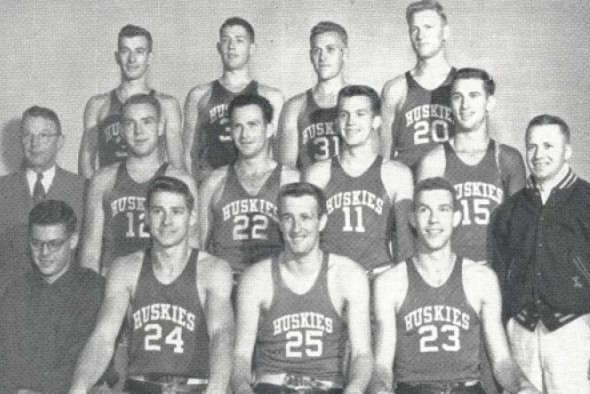
By David Eskenazi and Steve Rudman
One week ago, Forbes ranked Seattle as the “most miserable” sports city in America for the third consecutive year, rubbing our collective nose (again) in this sordid statistic: the city’s major professional franchises have produced only one paltry championship (1979 Sonics) in their 107 combined seasons (under Forbes’ way of calculating things, Seattle’s 1917 Stanley Cup win by the Metropolitans doesn’t count, nor do two WNBA titles by the Seattle Storm).
So no, Seattle will never be confused with “Titletown.” But in this wasteland of championships, where “three-peat” and “one for the thumb” constitute alien argot not likely to soon (or ever) pass through local lips, we have come painfully, anguishingly and mortifyingly close to rings on numerous occasions, often finishing second.
For want of a hit, shot or touchdown here, or a decent break by a ref or umpire there, Seattle could be moon-boot deep in ticker tape.
Of all the parades we coulda, woulda and shoulda had —2005 Seahawks (13-3), 2001 Mariners (116-46), 1994 Sonics (63-19), 1984 UW football (11-1), 1977 Sounders, 1959 UW football (10-1), to cite a few — the one that failed to take place 58 years ago this month might rank first on a list we could title “Alas, No.”
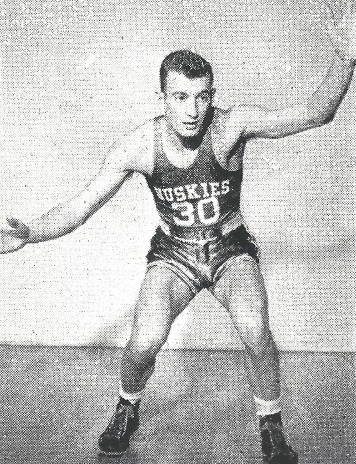
In fact, we probably would not even be ruing what could have been in March, 1953, if the U.S. stock market hadn’t collapsed 24 years earlier, in 1929. But that’s getting ahead of our story.
From Dec. 5, 1952, through Feb. 28, 1953, coach Tippy Dye’s senior-dominated University of Washington basketball team amassed a 23-2 record, losing only to No. 7 UCLA in Los Angeles Dec. 12, 1952, by four points (53-49), and at Idaho Feb. 27, 1953, by three points, 64-61. The Huskies first cracked the Associated Press rankings Dec. 19 — at No. 9 — following consecutive wins over No. 18 California, and climbed as high as No. 3 Feb. 7 after crushing Washington State 69-56.
Dye had already produced two of the best teams in school history. The 1951 Huskies went 24-6 and reached the NCAA Tournament’s regional semifinals. His 1952 squad — many believe this was Dye’s best team — went 25-6 and just missed the Tournament by losing to UCLA in the Pacific Coast Conference playoffs.
The main operatives on those 1951-52 teams also formed the core of Dye’s 1953 club, and all were locals: guards Joe Cipriano (5-11, Nooksack Valley) and Charlie Koon (5-11, Bremerton), forwards Doug McClary (6-8, Olympia) and captain Mike McCutcheon (6-1, Garfield) and center Bob Houbregs (6-7, Queen Anne).
“Joe (Cipriano) was as quick as anyone,” recalled Houbregs, now 79 and an Olympia resident. “He was a pesky type of player. He’d grab a lot of jerseys and shorts when the refs weren’t looking. He had a great one-handed shot and was a good passer. He’d pass the ball through legs or just past an ear to get it in to me, and I had to be ready for that.
“I loved the way Charlie Koon played: Smart, not especially fast, but knowledgeable,” Houbregs added. “He could really shoot, played good defense and was a good passer.
“Doug McClary was built like a rocket and played tight end on the football team (lettered 1951-53). He was strong, not much of a shooter, but a great defensive player and rebounder.
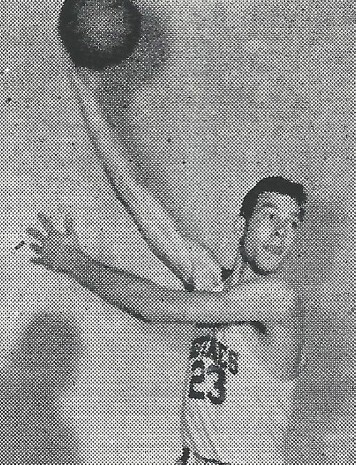
“Mike McCutcheon went to Garfield High and we’d played against each other for two years in high school. He was our captain and was as tough as nails. He played defense with the best of them. He was a good passer and could shoot, but that wasn’t his primary role on the team. One of the big reasons for our success was that everybody accepted their roles in the offense. It was a close team because we had gone through four years together.”
All five starters were recruited to UW by former major league baseball player Art McLarney (1948-50), who had succeeded the legendary Clarence “Hec” Edmundson (1921-47) as head basketball coach. Only Koon had not gone directly from a state high school to the Huskies: McLarney plucked him out of Olympic Junior College. The other four enrolled at UW in 1949, the same year football star Hugh McElhenny became a Husky and friend of Houbregs.
“I never really thought about going anywhere else but Washington,” Houbregs said. “My dad (Johnny Houbregs) told me if I was going to live in Seattle there was only one place to go.”
After McLarney resigned for personal reasons following the 1950 season, Dye exited the head coaching position at Ohio State to take over at Washington, mainly owing to UW’s lofty offer of $12,500 compared to Ohio State’s relative diss, $7,500. Dye also had an eye on expanding his resume and horizons, with the notion of one day becoming an athletic director.
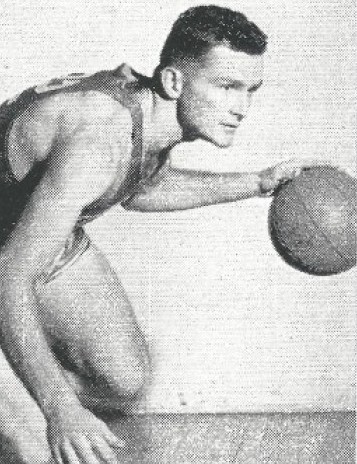
Dye, who earned nine letters in three sports at Ohio State (quarterbacking the Buckeyes to three consecutive victories over Michigan), had a huge impact on Houbregs, teaching him the hook shot that helped make him famous. As a consequence, Houbregs had by far the biggest impact on the Huskies. His freshman team went 21-1, his sophomore team 24-6, his junior team 25-6 and his senior team 28-3. In all, a varsity record of 77-15.
The 1953 Huskies averaged 72.3 points per game (no UW team would average more until 1967). Houbregs was responsible for 25.6 of the total (still the school single-season record and 2.6 points per game better than the No. 2 mark, Louie Nelson’s 23.0 in 1973). Houbregs also averaged 11.6 of Washington’s 43.3 rebounds per game, the principal reason why the Huskies outscored their opponents by 13.2 points on average, still the school mark nearly six decades later.
During the latter stages of the 1952-53 season, Houbregs had established himself as a strong candidate for NCAA Player of the Year, no small feat considering the national landscape — Walter Dukes, Tom Gola, Bob Pettit — with a string of offensive efforts that still pop out on Husky lists: a school-record 49 points vs. Idaho, 36 vs.California, 35 vs. Idaho, 33 vs. Oregon and Oregon State, 31 vs. California and 30 at Oregon, vs. Oregon State and at Washington State.
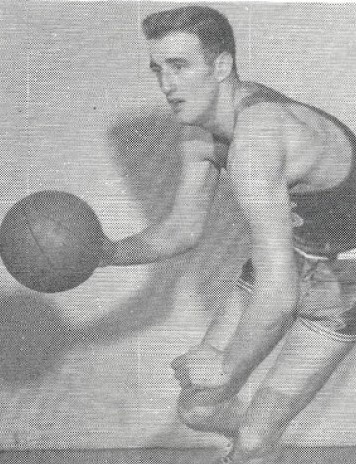
To qualify for the 22-team NCAA Tournament field, the Huskies needed to dispatch California in a best two-of-three PCC playoff series at Hec Edmundson Pavilion Feb. 13-14. When the Huskies won 60-47 (Cipriano 24 points, Houbregs 18) and 80-57 (Houbregs 31 points), oddsmakers couldn’t resist installing them as favorites to win college basketball’s biggest prize.
The twin wins over Cal also conveniently created the first-ever meeting, on March 13, between Washington and Seattle U., in the NCAA West Regionals at Gill Coliseum in Corvallis, OR., a matchup described in newspapers of the day as one of the most anticipated sporting spectacles in state history. Recognizing grandstand lather when it saw it, KING-TV became the first local television station to televise a game outside the state of Washington.
“It was a game that had been building for four years to a crescendo, once the O’Brien (Johnny and Eddie) twins came there,” said Houbregs. “We had played them twice as freshmen and they started having success, dramatic success. Seattle U. was right there with us in record (28-3). The media built up the game probably more than it should have because the players (Huskies and Chieftains) got along really well. The game also got taken over by the fans at each university, and some of what was said (on both sides) was not very nice.”
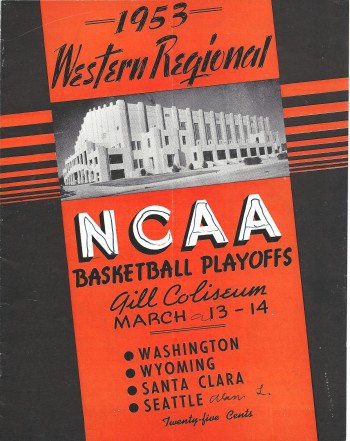
Largely because of Houbregs, Washington removed the drama early, racing to a big lead. The Chieftains put Wayne Sanford on the Washington star, then tried to double team him.
“They (Seattle U.) didn’t do it right,” said Houbregs. “Most of my teammates got me the ball in the right place at the right time. Stupid me, I missed my first layup,” (Dunks not allowed in that era of college basketball.)
But not much else. With Houbregs converting layups and swishing hooks, Washington rolled over the Chieftains. With three minutes to play, Houbregs took his 43 points to the bench, but Husky fans cried for Dye to put him back in so he could break the NCAA Tournament record of 44 set by Clyde Lovellette of Kansas a year earlier. Houbregs quickly scored his 44th and 45th points and returned to the pine (the record would stand until Hal Lear of Temple scored 48 against Southern Methodist in 1956).
“We took them out of it pretty early,” said Houbregs, whose Huskies prevailed 92-70 (first-team All-America Johnny O’Brien scored 25 for the Chieftains).
The next night (March 14), Washington received a far stiffer assignment in a 74-62 win over Santa Clara.
“That was a tough game,” said Houbregs. “Santa Clara had been in the Final Four the prior year and had most everybody back, including a great player named Kenny Sears (on Dec. 20, 1954, Sears became the first basketball player to appear on the cover of Sports Illustrated). I remember most of all playing against a center, Mickey Mount, who beat on my back and yelled at me the whole game until he fouled out. We went ahead late in the third quarter (Houbregs hit a two-handed shot from half-court to put UW ahead 53-51), and wound up beating them by 12. But it was a tight game.”
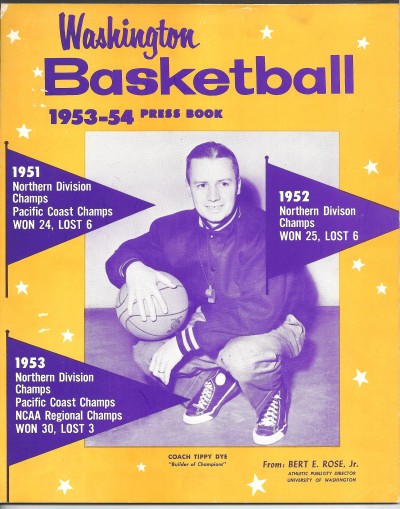
In 1953, a year in which Watson and Crick first described the structure of DNA and Hugh Hefner put Marilyn Monroe on the cover of the first issue of Playboy, only two days separated the regional finals and the first Final Four game (“Final Four” not officially used until 1975). After beating Santa Clara on a Saturday, the Huskies flew to Kansas City Sunday in a propeller-driven plane, joining Kansas, Indiana and LSU in the national semifinals (1953 NCAA Tournament bracket). UW practiced Monday and faced defending national champion Kansas, coached by Phog Allen, Tuesday evening at the Kansas City Civic Auditorium. The Huskies weren’t ready, and even if they had been, it probably wouldn’t have mattered.
“Everybody was so hyper for the Seattle U. game,” said Houbregs. “We were really ready for that. We expended a lot of energy. When we played Kansas, I don’t think we were ready. We were a better team, I believe, but we just didn’t have any energy.”
Worse than an energy drain, the Huskies lacked the one ingredient they couldn’t do without — Houbregs. He collected four fouls in the first half and his fifth with 2:14 gone in the third quarter. When Houbregs departed, UW fell apart. To Washington’s players and coaches, it seemed as if Houbregs drew fouls merely by breathing. And talk about bad timing: It marked the first time in 57 games that Houbregs departed with excess fouls. That night’s officiating crew provoked UW fans into a roaring snit that rivals the community-wide fluster that followed the Seahawks’ loss to Pittsburgh in Super Bowl XL.
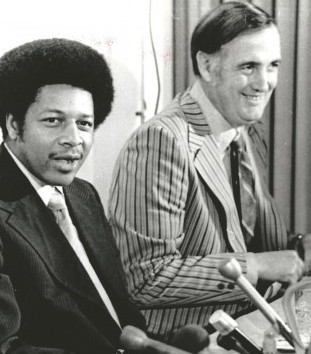
“I’d never gotten four fouls in the first half of any game in my career,” said Houbregs. “Not even close. My last foul was a fair call: I got off balance and fell into a player. But the other four fouls I didn’t deserve. They were touch fouls, really.”
With Houbregs missing and Kansas playing a fierce, pressing physical game against Washington’s guards, collecting 14 steals (“nothing was called,” said Houbregs), the Jayhawks raced to a 79-53 victory, the worst loss of Tippy Dye’s career at Washington.
“It was very disappointing we didn’t play in the final,” said Houbregs, who scored 18 points in limited minutes. “I just wish we could have played our best against Kansas. I thought we had the best team in the country. It’s a shame we weren’t able to prove it. A supreme letdown at the time.”
One night later, Washington retaliated with an 88-69 destruction of All-America Bob Pettit’s Louisiana State Tigers. Houbregs sealed his NCAA Player of the Year award, bestowed by the Helms Foundation, by knocking down 42 points. Soon to carve a Hall of Fame career in the NBA, Pettit tallied 36. Pettit wanted to know why Houbregs scored more points than he did. Houbregs told him, “You didn’t get the ball enough.”
Within six months, all five UW starters had been recruited to play for the Buchan Bakers (team sponsored by the Seattle-based Buchan Baking Co.) of the Northwest AAU League. Both Bob and his father, Johnny, were given jobs at the bakery, but shortly thereafter, Bob, the No. 2 overall pick in the NBA draft, signed a contract with the Milwaukee Hawks and departed. Koon, Cipriano, McCutcheon and McClary joined the Bakers.
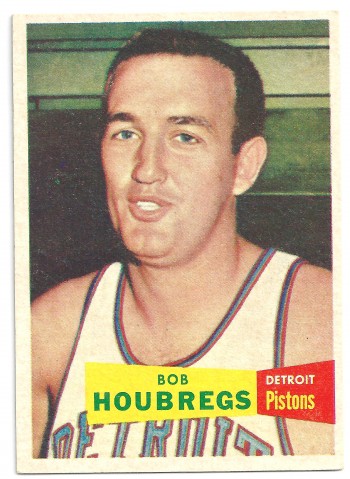
Houbregs played five NBA seasons, retired due to injury, went to work for Converse, and eventually became the general manager of the Seattle SuperSonics, a position he held from 1970 through 1973.
After his playing days, Cipriano entered the coaching dodge, starting as a UW assistant. He spent time at Idaho (coached Gus Johnson) before Dye, who left UW after the 1959 season to become athletic director first at Wichita State and then at Nebraska, hired him to become the Cornhuskers’ head coach.
While Cipriano became the winningest coach in Nebraska basketball history (254-196), Dye helped build Nebraska into a national football powerhouse. Cipriano died of liver cancer in 1980 at age 50.
“Great, great guy,” said Houbregs.
Charlie Koon entered the teaching profession, working in the Shoreline School District, where he also coached. Koon is deceased, as is McClary, who relocated to North Carolina, where he worked for Georgia Pacific (McClary’s daughter, Carlin, played basketball at UW).
Other than Houbregs, McCutcheon is the only living starter from that 1953 team. He owned a construction company for many years, then became a Kirkland-based realtor. In 2008, he organized a reunion for Dye, now 96, and all the Huskies who played for him.
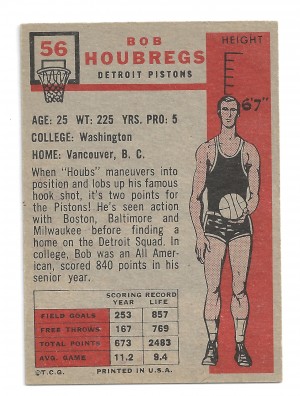
Houbregs is enshrined in every Hall of Fame available to him — Basketball Hall of Fame (1987), State of Washington Sports Hall of Fame (1969), Husky Hall of Fame (1979) and Canadian Basketball Hall of Fame (2000). And he is the principal reason the 1953 Huskies are the only basketball team in school history memorialized in the UW Hall of Fame (1985).
Houbregs remains the only consensus All-American in UW history, its only national Player of the Year, and the first player to have his number (25) retired (later joined by Brandon Roy).
He still holds 10 school records, including the top three scoring games in UW history — 49 vs. Idaho on Jan. 10, 1953, 45 vs. Seattle U. on March 13, 1953, and 42 against LSU on March 18, 1953.
Speaking of threes, his 1949 freshman classmate and friend, McElhenny, left Washington for the NFL in 1951 with this terrific trifecta: he’s the only player in school history to score on 90-yard plays three different ways — 91-yard run against Kansas State in 1950, 96-yard kickoff return against Minnesota in 1949 and a 100-yard punt return against USC in 1951.
McElhenny entered the Pro Football Hall of Fame in 1970, the College Football Hall of Fame in 1981, and the Husky Hall of Fame in 1979, along with Houbregs (inaugural class).
But Houbregs’ rich individual legacy, as well as that of the so-close 1953 team, might not have happened at all had the U.S. financial markets not collapsed in October, 1929, three years before Houbregs was born.
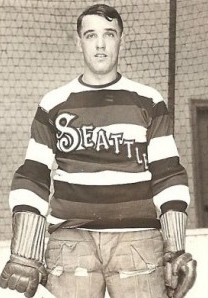
In 1929, Johnny Houbregs, born in 1908 in Belgium, lived in Calgary (he met his Scotland-born wife there), the son of a coal miner, and had become a hockey player of some distinction, at least good enough to draw the attention of Walter Brown, then owner of the Boston Bruins, who wanted to purchase him.
The sale fell through — Brown was willing to spend $25,000 — when the stock market went belly up.
“I didn’t find this out until I was playing in the NBA,” said Houbregs. “I was in the old Boston Garden. You had to walk behind the stands to get to the dressing room.
“Anyway, this gentleman walks toward me, stops and says, ‘Excuse me. My name is Walter Brown (also the owner of the Celtics), and I’d like to tell you a story. We tried to buy your father in 1929. But the stock market crashed and after that we could get anybody we wanted for nothing.'”
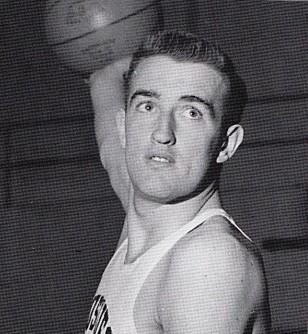
Washington’s sporting history might look dramatically different if Wall Street hadn’t imploded, the key reason Johnny Houbregs never reached the National Hockey League.
Had he done so, Bob Houbregs might have been born in Boston or environs and perhaps attended Boston College, Holy Cross or the University of Massachusetts. He might have never stepped foot in the state of Washington. In other words, a lifetime of deeds and memories and the Houbregs legacy that is rooted here, might have been a lifetime of the same rooted there, or elsewhere.
Instead, father Johnny continued to play for various teams in Canada, reared Bob in Vancouver, B.C., and moved to Seattle when he signed in 1935 to play for the Seattle Sea Hawks, a new franchise in the five-team Northwest Hockey League that had replaced the defunct Seattle Eskimos.
“Dad was a great athlete, but I was too young to see him play. He lost an eye from a hockey stick,” said Bob, who never had an affinity for that sport. “I couldn’t skate worth a lick. I think I made the right choice. And while I never thought it about it that way, maybe the stock market crash was a good thing for me.”
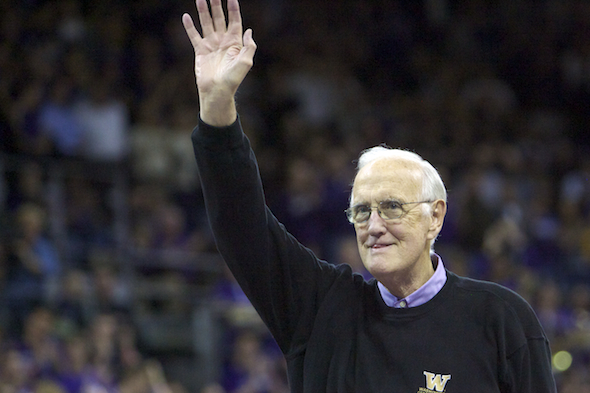
——————————————–
Many of the historic images published on Sportspress Northwest are provided by resident Northwest sports history aficionado David Eskenazi, who writes The Wayback Machine every Tuesday. Check out Davids Wayback Machine Archive. David can be reached at (206) 441-1900, or at seattlesportshistory@gmail.com

57 Comments
I was a freshman player in 1953 and had to check Bob in practice one-on-one as Tippy would feed him the ball. He hardly ever missed those long hook shots and when you cheated to get at the ball he would drop-step and lay it in. Bob was also a remarkable passer who could easily hit a teammate for an open shot when he was double-teamed. I sat behind the Husky bench the two nights he scored 49 and 35 against Idaho. I remember the Friday night game especially because Bob had been shooting poorly (for him) the previous game or two. That night, as he was warming up shooting long hooks, the crowd would cheer louder and louder as he dropped in shot after shot. To this day, Bob is one of the most modest people you will meet which belies his fierce competitive nature (just get him on the golf course and you’ll see what I mean). All in all, just as wonderful human being.
Jim: Thanks so much for offering your thoughts. I spoke with Bob extensively the other day and he is quite a human being. Again, thanks for visiting our web site and reading. Have a great day.
When ranked “most miserable” by Forbes they obviously are not acknowledging our sports writers and broadcasters which in my humble opinion are the best in the country.Thanks so much for another great article Steve!
Thanks so much for reading and commenting. We really appreciate it.
I knew I liked Tippy Dye–He beat Michigan! Sure wish I could have seen that Husky team play.
Gretchen: Thanks so much for writing to us. BTW: “Tippy” comes from “Typpycanoe and Tyler too” a long-ago political campaign slogan.
Many people don’t know Bob Houbregs and then SPU coach Les Habeggar ran a basketball camp in the summer on Whidbey Island in the 60’s. Long before team camps, this is where kids who loved hoops went to learn. Guest coaches included Bucky Buckwalter, Bob Boyd, and Tex Winter. Bob’s mother and wife ran the kitchen. They were as gracious and well liked as he was. When one factors in the era he played in, it is hard to argue that he wasn’t the greatest Husky of all time.
I was born in 1961, so I don’t remember much of 1953. Nevertheless, must’ve been pretty cool back then.
He could have the same kinship as me. because the way “Houbregs” is spelled is very rare in Belgium. And since I live in Genk a coal mine city and i have family in Canada it couldn’t be the other way :D. I love Basketball so it would be nice :)
The commentators on ESPNU had the Huskies analyzed pretty well. “Underperforming”…”lazy defense”…”mental mistakes”…and “giving up too many second shots to the opposition” were some of the words and phrases that kept cropping up. 1coolguy is tough on Romar but there is some truth to the points he makes. Without a fiery, determined floor leader, the team has not generated intensity. The coach is supposed to provide the intense, will-to-win mentality which characterizes successful teams. The Huskies broke away and won last night against mediocre competition.
Let us see how they do Friday against a disciplined, well coached Northwestern team.
Again, don’t put it all on Romar. The man knows what he’s doing. He’s got players who aren’t Roy, Robinson, Conroy or Brockman.
”
Washington was not rated the 69th best team in the country by the selection committee. Far from it.” Todd this makes you sound like an idiot. The Committee doesn’t rank the nation. There are things called automatic bids. Do you really think the committee thought that Detriot, and Lamar were better teams than UW? This is your job try….
It’s dangerous to try and understand what is in someone else’s mind. To try and predict their motivations based upon how they play a game. Unless you know something you are not saying…. then it is just your own speculation and tells us much more about how you think then how Wroten is thinking. Personally, my WIJI board and throwing of the bones tells me Wroten will return for at least one more year, and show marked improvements in all areas of his game making the Huskies a serious contender next year. If not….not.
Wroten says he wants to help the Huskies win. Whether for selfish reasons or altruism, winning is what will raise Wroten’s stock more than anything else. If being a one man team would help the Huskies win at a higher percentage, then that is what he ought to do….though that has never been a successful strategy for any team – so even if Wroten is using logic and reason to determine his strategy, passing the ball to more polished shooters is both selfish and altruistic.
Yesterday, he tried to force drives into the paint late in the game and once again failed to help his team. Passing to CJ late so CJ would be the one fouled was the smartest thing he did. He has lots of room for improvement – maybe more than is possible to achieve in just one year. Another year as a Husky is probably the smartest thing he can do for himself. Maybe two or even three more years.
For the Huskies’ sake, I hope so.
What I want to know is how fast they’ll dump that waste of space, the Figlet, when he continues to be a non-producer.
And the story didn’t make it clear who’s the CF until Guti’s back. I thought that’d be Saunders, who’s clearly earned a job.
Read my column to be posted Sunday
I agree completely. I will be very, very disappointed if Wilson doesn’t get a shot to show what he can do against another teams first-string D.
I won’t be shocked to see Flynn start, but Wilson needs to prove or dispel his ability to handle a starting NFL defense at such an early career stage, based on Pete’s unusual belief in him.
Spot on, Art, I hope Pete Carroll listens.
I personally can’t wait to see Wilson run the 1st unit. He’s looking great so far, quick on his feet, good decisions, bullet passes downfield, confident.
And, we’re not alone. Here’s the results of a Seattle Times poll asking the question which Seahawk players or units have stood out so far in pre-season:
Matt Flynn 7.69% (23 votes)
Russell Wilson 67.89% (203 votes)
Marshawn Lynch 3.34% (10 votes)
Seahawks pass defense 21.07% (63 votes)
Total Votes: 299
Carroll knows better, Obi, than to play to popular sentiment, but he’s always been a risk-taker in personnel. I’ve never seen him in Seattle quite as jacked about a single player as Wilson. Might make him a fool, but he lessens that chance with a start of Wilson.
Agreed. Whoever starts the third preseason game must be your starter in week 1. This isn’t the time to mess around. The competition has to be over by tomorrow. Flynn needs all the reps he can get, and the team must get behind him as the starter.
Coach Bubbles (you got to love PC) has to walk his talk and give Wilson time with the first unit. The kid has earned the opportunity
Odd situation, but Carroll wanted it, so he has to follow through,
Have to agree Art! I was in the get some-reps-and-continuity-for-Flynn camp until last night. Wilson looks awesome, and individual performance aside, the timing for the whole team looks better when he’s in. Even if the hawks went 500 this season they would be a blast to watch with him in control.
It is interesting to consider however that if 1. TO caught the perfectly thrown TD pass from Flynn and if 2. Wilson’s horribly underthrown TD catch against the Titans had turned out differently, this controversy would not have nearly as much legs.
Lots of if-thens in exhibition play, but when you do QBs in threes there’s never enough game or pratice time for thorough evals. Carroll is definitely out there in this one because Flynn will take it hard if he is a backup AGAIN, even if he gets starter’s money. I think they will go with Flynn against AZ, but it will get wild if Wilson lights it up vs. KC.
Flynn has been playing football his entire life and should be used to the idea that someone can come in and take over his job, by now. The talk about him being negatively affected by that shouldn’t be as much of an issue. He needs to come in and demand the job with his performance and he hasn’t been horrible, but he wasn’t good on Saturday either. It’s life as a professional athelete. If he doesn’t prove himself, he knows it’s on him.
Why not? It’s still a preseason game and, no, you don’t have to have your starters named with two games to play before they start counting. That’s why it’s called a competition. Let’s see what Wilson can do with the first unit next weekend at KC. If he’s not ready, plug Flynn back in and call him your season-opening starter.
I realize that NFL custom is to go with your ones in the third fake game, but is not customary to put a third-rounder into competition with two veterans. Customs are not rules. It’s like the nonsense about having broadcasters not discuss a no-hitter in progress. That isn’t in the Constitution, the Magna Carta or J.P. Patches Clean Plate Club. Carroll may be nuts, but he’s got to play the hand.
‘Chaos Theory’. Good one. But I would say that is a better descriptor of Carrol’s approach to the competition than Art’s commentary. LOL.
Read the comment below regarding the game three custom. It’s already out the window with the three-QB deal. You’re right about the contract being (mostly) non-guaranteed. I think Wilson will have a struggle with No. 1s, and Flynn is currently more likely to do well in the first real game. But Carroll senses something about Wilson that none of us on the outside can’t know. So forget the game 3 habit. Inoperative.
What makes you think Wilson will struggle against the ones? What do you think are his weaknesses?
Gotta go with Flynn Art. I think Flynn has looked slightly better than Wilson, and he has the advantage of some experience versus being straight out of college. Got to go with Flynn until Flynn proves to make bad decisions. Saturday, I believe he was the victim of having to play the first quarter with T.O; otherwise his numbers would have looked much better.
The misconnections with TO were a mixed bag. The first back shoulder throw wasn’t a good choice because the CB wasn’t over-pursuing, that’s why TO went for the back of the endzone where he was wide open. There were other routes that he ran wrong but 3/5 were bad throws or decisions by Flynn and the other 2 were on TO. They were all miscommunications but it wasn’t all TO. You have to hold Flynn to some of them.
TO did drop that wide open TD pass. I’ll give you that though. Had he caught that, it would look a bit different, but I think Wilson would’ve made more out of the first broken pockets and wouldn’t have held the ball as long as Flynn.
Why does everyone keep on making the Flynn-didn’t-have-all-his-weapons excuse? Wilson doesn’t either. Yes, he’s playing against the second unit defense, but with the talent of his second unit offense. And doesn’t that level the playing field? Or, is there some little known rule that the second unit offense is always superior to the other team’s second unit defense?
In this league, where the competition is fierce and the difference between a win and a loss often comes down to a play or two, Wilson is far more dynamic of the two, and deserves a chance to state his case.
Flynn plays, in practice, with the starting first-teamers. He gets 2nd teamers in-game. Wilson practices with 2nd and 3rd teamers. He gets 2nd and 3rd teamers in-game. That’s the problem.
start Flynn, as soon as he goes down, Wilson won’t relinquish the job. #12thMan
If that’s the case, then why not start him now? The idea that Matt Flynn would lose the job to Wilson and never get it back if he were to get injured, should right away say that Wilson should be in now. Why wait for an injury?
The first string didn’t protect him well, according to Carroll, so what’s the difference?
I believe that Flynn will be the starting QB on opening day and thus needs to start and play the first half on Friday. I’m impressed so far by Wilson, but I cannot see going with a rookie QB to start the season. Our defense isn’t THAT good yet.
The thought of starting Flynn over Wilson is intriguing, but there is no way the Hawks should eat a 3-year, $26-million contract before allowing Flynn a chance to start a meaningful game. Giving Wilson a year to learn the system from the sidelines will only help his career down the road. Let’s remember that Flynn has only started a pair of games. If memory serves me correctly, it took the most successful quarterback in Seahawks history almost a full season before he looked NFL ready.
No reason to jump ship on the Bayou sensation just yet.
“Only” $10 million of that contract is guaranteed, Adam, so the Hawks aren’t on the hook for the other $16 million. Yes, his contract does give Flynn an advantage over Wilson as far as Paul Allen and his accountants are concerned, but Pete Carroll isn’t a CPA. He’ll go with whoever he thinks he can win with.
Lighten the hell up Radright or go troll in other waters. You obviously have no sense of humor which isn’t a surprise given your handle.
Thanks Art! Love your writing as always!
He types, therefore he be.
Yeah, why would Art report on the most recent Seahawk game? What’s that about?
Art, you must wonder about some of these reader responses. It’s like, they haven’t even read the article before they start ranting away in the comment section. weird.
Life in the interwebs, Tian. No IQ test required to play. Like Wheel of Fortune.
Anything done in preseason should be taken with a grain of salt, but I was glad to see Matt Flynn step in and have a solid night (even though it was against a second-rate team like Oakland). Wilson has won the starting berth fair and square, but it wasn’t because Flynn had played poorly…Russ brings a certain dynamic to the game that Matt doesn’t yet.
At any rate, a win’s a win (even if it doesn’t count) and the table’s been set for a potentially very good regular season. The NFC West is definitely winnable.
Wilson has yet to experience a pro D that schemes against him. Obviously, the book on him is small, but it’s not like he’s playing a different game than most mobile quarterbacks. It’s a matter of the right blend of protection and play calls that give him the highest chance for first-game success. And Arizona seems like a team in sufficient disarray that would help Wilson’s first outing.
woo hoo we’re AFC West Champs…or something…
Thanks for the breaking news, radright. No one knew that about the fourth X game. Wonder why they played it.
Speaking of the black holes of the Seahawks QB universe and epochal history, wouldn’t Russell Wilson be well served to ditch the number 3 (that of previous rookie starting quarterback Rick Mirer) and go back to his UW Badger number of 16 now that cutdowns are complete?
At least those of us who see karma as a universal force also would think it prudent.
It exciting to see the potential here. I’m tempering my enthusiasm but these guys could bring something to the party this year. Great article as always, Art.